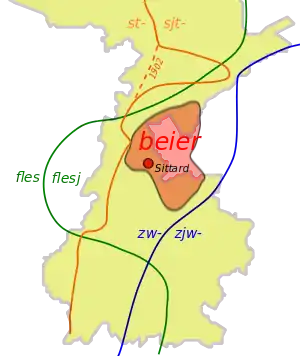Sittard dialect
The Sittard dialect (Dutch: Sittards, Limburgish: Zittesj) is a Limburgish dialect spoken mainly in the Dutch city of Sittard. It is also spoken in Koningsbosch and in a small part of Germany (Selfkant), but quickly becoming extinct there. Of all other important Limburgish dialects, the dialect of Sittard is most closely related to that of the Roermond dialect.
| Sittard dialect | |
|---|---|
| Zittesj | |
| Pronunciation | [ˈzɪtəʃ] |
| Native to | Netherlands |
| Region | Sittard |
Indo-European
| |
| Language codes | |
| ISO 639-3 | – |
| Glottolog | None |

Characteristics
The Sittard dialect belongs to East Limburgish, which means it has a postalveolar consonant at the onset of words beginning with clusters such as sl and st, in contrast with other variants of Limburgish such as Maastrichtian and in Dutch.
The most important characteristic which distinguishes the dialect of Sittard from adjacent Limburgish dialects is the so-called Sittard diphthongization, i.e. the replacement of the close-mid monophthongs ee, eu and oo with the wide diphthongs ei, ui and ou in some words such as neit ("not"), veil ("fall") beier ("beer") and awd ("old"). It is largely the same as the Polder Dutch phenomenon in Standard Dutch, though it does not affect the original closing diphthongs /ɛi, œy, ɔu/ and it is extended to the environment before /ʁ/ (where an epenthetic schwa is inserted before the consonant). This phenomenon was first examined thoroughly in the first half of the 1940s by Willy Dols, who showed that this Sittard diphthongization typically occurred in syllables with a push tone. New research at the beginning of the 21st century has shown that the diphthongization once served to emphasize the difference in vowel length which distinguishes syllables with a push tone from those with a dragging tone.[1][2][3]
Phonology
Vowels
| Front | Central | Back | ||||||
|---|---|---|---|---|---|---|---|---|
| unrounded | rounded | |||||||
| short | long | short | long | short | long | short | long | |
| Close | iː | yː | u | uː | ||||
| Close-mid | ɪ | eː | øː | ø | o | oː | ||
| Open-mid | ɛ | ɛː | œ | œː | ə | ɔ | ɔː | |
| Open | æ | aː | ɑ | |||||
| Diphthongs | ɛi œy ɔu ai au | |||||||
- Among the central vowels, /ø/ (phonetically [ɵ]) is the short counterpart of the front /øː/, whereas /aː/ is the long counterpart of the back /ɑ/. /ə/ is restricted to unstressed syllables.
Consonants
| Labial | Alveolar | Palatal | Velar | Uvular | Glottal | ||
|---|---|---|---|---|---|---|---|
| Nasal | m | n | ɲ | ŋ | |||
| Plosive | voiceless | p | t | c | k | ||
| voiced | b | d | ɟ | ɡ | |||
| Fricative | voiceless | f | s | ʃ | x | ||
| voiced | v | z | ʒ | ɣ | ʁ | ɦ | |
| Approximant | central | β | j | ||||
| lateral | l | ʎ | |||||
Pitch accent
As many other Limburgish dialects, the Sittard dialect features a contrastive pitch accent.[3][6][7]
Literature
- Belemans, Rob & Keulen, Ronny (2002): Taal in stad en land. Venloos, Roermonds en Sittards ISBN 90-12-09014-8
References
- http://www.let.ru.nl/gep/carlos/dols43.pdf
- Carlos Gussenhoven Over het waarom van de Sittardse diftongering Radboud Universiteit Nijmegen in Dutch
- De Sittardse Diftongering | Willy Dols Stichting
- Gebruikte tekens in het Sittards | Willy Dols Stichting
- On-Nederlandse klinkers | Willy Dols Stichting
- Schelberg, P.J.G. (1986) [1979], Woordenboek van het Sittards Dialect (PDF) (3rd ed.), Amsterdamer Publikationen zur Sprache und Literatur
- Typische spellingsproblemen 3 | Willy Dols Stichting